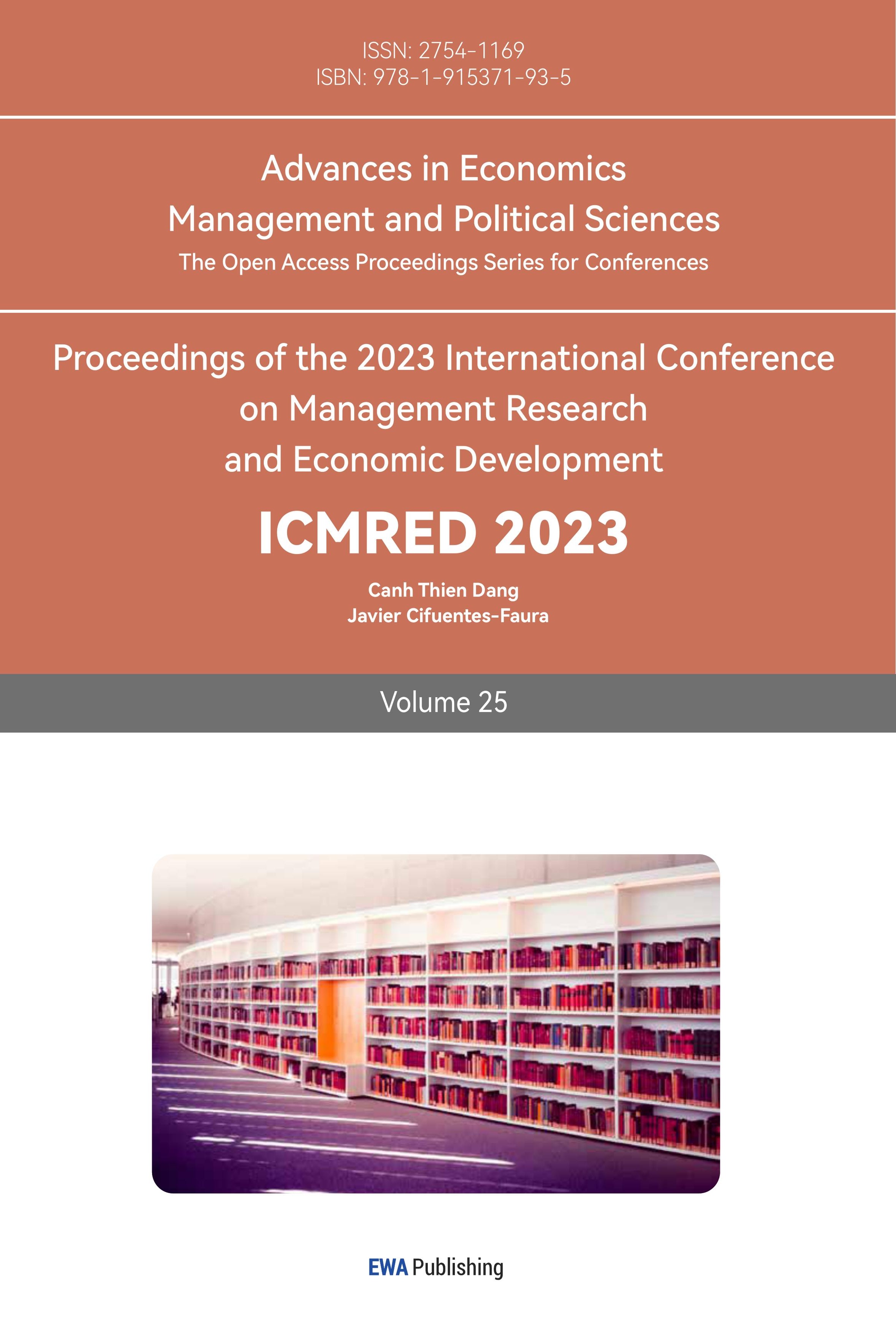References
[1]. Gardner, K.: Beauty during a pandemic: the impact of COVID-19 on the cosmetic industry. University Honors College Middle Tennessee State University (2021).
[2]. Jalil, P., Masood, S., Naveed, S., Tabassum, S.: COVID-19 pandemic & skin care guidelines for health care professionals. Pakistan Journal of Medical Sciences (2020).
[3]. Dumonceaux, M. D., Kumar, S., Massie, C.: Comparative innovative business strategies of major players in cosmetic industry. Industrial Management & Data Systems (2006).
[4]. Howerton, A. B.: The Estee Lauder Companies background and history. The University of Tennessee-Knoxville (2002).
[5]. Chaubey, D. S., Ghufran, A., Husain, S.: Relevance of social media in marketing and advertising. Splint International Journal of Professionals 3(7), 21-28 (2016).
[6]. Fan, J.: An analysis of Estee Lauder and impact of COVID-19 pandemic. Proceedings of Business and Economic Studies 4(1), (2021).
[7]. Peng, T.: From semiotic perspective: Male endorsements in cosmetic advertising. In International Conference on Educational Innovation and Philosophical Inquiries 62-73 (2020).
[8]. Feng, X.: Research on the Estée Lauder Group's brand marketing strategy from the perspective of webcasting. Jiangxi Normal University (2021).
[9]. Digital integration development to create "China's leading brand of high-end cosmetics"——extracted from the case of Lin Qingxuan, a brand-leading demonstration enterprise in Shanghai in 2020. Shanghai Quality (10), 31-34 (2021).
[10]. Jiang, X.: Challenges and opportunities for the beauty industry during the pandemic. In 2021 3rd International Conference on Economic Management and Cultural Industry, ICEMCI 2021, 2018-2021 (2021).
Cite this article
Jia,S. (2023). Comparative Analysis of Marketing Strategies of Estee Lauder and Lin Qingxuan in Response to COVID-19. Advances in Economics, Management and Political Sciences,25,322-327.
Data availability
The datasets used and/or analyzed during the current study will be available from the authors upon reasonable request.
Disclaimer/Publisher's Note
The statements, opinions and data contained in all publications are solely those of the individual author(s) and contributor(s) and not of EWA Publishing and/or the editor(s). EWA Publishing and/or the editor(s) disclaim responsibility for any injury to people or property resulting from any ideas, methods, instructions or products referred to in the content.
About volume
Volume title: Proceedings of the 2023 International Conference on Management Research and Economic Development
© 2024 by the author(s). Licensee EWA Publishing, Oxford, UK. This article is an open access article distributed under the terms and
conditions of the Creative Commons Attribution (CC BY) license. Authors who
publish this series agree to the following terms:
1. Authors retain copyright and grant the series right of first publication with the work simultaneously licensed under a Creative Commons
Attribution License that allows others to share the work with an acknowledgment of the work's authorship and initial publication in this
series.
2. Authors are able to enter into separate, additional contractual arrangements for the non-exclusive distribution of the series's published
version of the work (e.g., post it to an institutional repository or publish it in a book), with an acknowledgment of its initial
publication in this series.
3. Authors are permitted and encouraged to post their work online (e.g., in institutional repositories or on their website) prior to and
during the submission process, as it can lead to productive exchanges, as well as earlier and greater citation of published work (See
Open access policy for details).
References
[1]. Gardner, K.: Beauty during a pandemic: the impact of COVID-19 on the cosmetic industry. University Honors College Middle Tennessee State University (2021).
[2]. Jalil, P., Masood, S., Naveed, S., Tabassum, S.: COVID-19 pandemic & skin care guidelines for health care professionals. Pakistan Journal of Medical Sciences (2020).
[3]. Dumonceaux, M. D., Kumar, S., Massie, C.: Comparative innovative business strategies of major players in cosmetic industry. Industrial Management & Data Systems (2006).
[4]. Howerton, A. B.: The Estee Lauder Companies background and history. The University of Tennessee-Knoxville (2002).
[5]. Chaubey, D. S., Ghufran, A., Husain, S.: Relevance of social media in marketing and advertising. Splint International Journal of Professionals 3(7), 21-28 (2016).
[6]. Fan, J.: An analysis of Estee Lauder and impact of COVID-19 pandemic. Proceedings of Business and Economic Studies 4(1), (2021).
[7]. Peng, T.: From semiotic perspective: Male endorsements in cosmetic advertising. In International Conference on Educational Innovation and Philosophical Inquiries 62-73 (2020).
[8]. Feng, X.: Research on the Estée Lauder Group's brand marketing strategy from the perspective of webcasting. Jiangxi Normal University (2021).
[9]. Digital integration development to create "China's leading brand of high-end cosmetics"——extracted from the case of Lin Qingxuan, a brand-leading demonstration enterprise in Shanghai in 2020. Shanghai Quality (10), 31-34 (2021).
[10]. Jiang, X.: Challenges and opportunities for the beauty industry during the pandemic. In 2021 3rd International Conference on Economic Management and Cultural Industry, ICEMCI 2021, 2018-2021 (2021).









